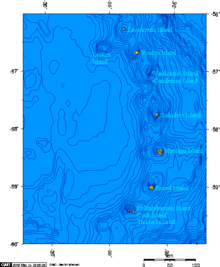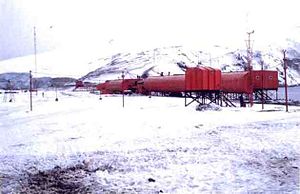Operation Keyhole
| Operation Keyhole | |
|---|---|
| Part of Falklands War | |
 South Sandwich Islands | |
| Type | Special operation |
| Location | |
| Objective | Recapture Thule Island |
| Date | 19–20 June 1982 |
| Executed by | 1 frigate 1 icebreaker 1 fleet tanker 6 helicopters 2 rifle troop units (from 42 Commando)[1] |
| Outcome | Operational success |
| Casualties | 1 civilian and 9 Argentine military personnel captured |
Operation Keyhole was a British special operation to recapture Thule Island in the South Sandwich Islands during the Falklands War. The operation took place from 19 to 20 June 1982.[1]
Background

A base, called Corbeta Uruguay, had been built by Argentina in part to reinforce its territorial claims on British-held territory in the South Atlantic. Ostensibly a meteorological research station, it was also used by Argentine military personnel. The British government became aware of the base in December 1976.[2] Between then and the outbreak of the 1982 war, Britain had failed to reach a diplomatic solution to the problem.
Operation
After the Argentine surrender on the Falkland Islands on 14 June 1982, a task force composed of frigate
Ten prisoners (one civilian and nine military personnel) were evacuated to the tanker Olmeda, accompanied by Yarmouth and they departed for South Georgia. The Argentine base "Corbeta Uruguay" was closed and the buildings sealed to make them weatherproof. The other ships Endurance and MS Salvageman followed and were back at Cumberland East Bay,
Aftermath
In March 1983, a UK spokesman said that on 19 December 1982, the research vessel, HMS Hecate, had discovered someone had been back to the base, had lowered the British flag, and raised the Argentinian flag in its place. The spokesman said: "We haven't a clue what went on and God only knows who it was—scrap metal merchants, someone in their cups (drunk) or the Argentine military". To prevent any attempt by Argentina to return to Thule Island, the base was later demolished, in February 1983, by crew from HMS Ariadne and the supply ship RFA Tidespring. The flagpole, two weather beacons, and a fully provisioned hut were left intact.[4]
See also
References
- ^ ISBN 978-1848320437. Retrieved 22 September 2018.
- ISBN 978-0-7146-5206-1.
- ^ "The race to regain Thule". Navy News p.21. August 1982.
- ^ "A band of 'visitors' landed on a remote, uninhabited..." United Press International. 11 March 1983. Retrieved 23 September 2018.
